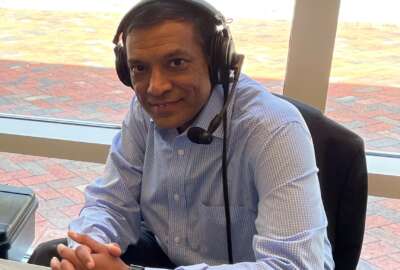Army’s new CIO prioritizes software policy
The Army’s new CIO wants to codify regulations for new software and data capabilities as he plans for new data platform contracts next year.
The speed of software innovation in industry has the Defense Department struggling to keep its policies on pace with what the commercial sector can provide. To address the problem, the Army’s new chief information officer said he is prioritizing new policy for cybersecurity, software and data to try and keep up with technological advances.
His first effort — developing interim policies that address immediate challenges while working on bigger, all-encompassing guidelines.
“You see a really big focus on policy, and there’s a reason for that — it’s a space where we’ve kind of waited to do it. We’re going to change these long-standing huge policies that are out there in the Army,” Leonel Garciga, the Army chief information officer, said Wednesday at an AFCEA TechNet conference in Augusta, Ga.
Garciga stepped into the position at the end of June after working as the director of information management for the Army G2 since 2019. After taking over, he went to work standardizing compliance and minimizing risks associated with Army software and data.
“We’re not moving as fast as everybody else is right now. The programs are moving too fast. Capabilities out in private industry are moving too fast. We have to adjust the way we do this,” Garciga said.
He said the Army has made huge steps forward in its software and data capabilities, but it’s time to take stock and reorganize.
“We’ve done these massive sprints — we’ve moved forward, now we have to kind of codify and institutionalize that. I think the first piece that I’m really focused on right now is what are those critical enablers on the policy side to actually start to institutionalize some things,” Garciga said.
While codifying software policy may take some time, the first step will include interim policies — some of which are close to completion.
Among the first interim policies scheduled for release is a container policy. The use of containers has grown in popularity as a method of efficiently packaging and deploying software, but with that agility comes new security risks because scans can’t always see what inside the containers.
“We’re going to focus on some things that are huge leaps, both from a security perspective and from the ability to build software out faster. Container guidance — that’ll be coming out soon. My team is cringing right now because I told them I wanted it yesterday. They’re working hard to get it done,” Garciga said.
Another short-term policy effort Garciga wants to push forward is guidance on the use of public data on government platforms. After focusing on Army data platforms while working in intelligence, he said his office will soon be releasing new guidance to try and standardize how that data is used.
“We need to remind folks that there are some rules around this, and we need to protect DoD data and we need to protect personal information too. We’re going to be putting some stuff out there,” Garciga said.
In addition to creating guidance for how data is used, the Army will be looking for new data platforms with requests for proposals going out next year. Garciga said the new capabilities will move the Army forward with operationalizing its data strategy and getting it to scale and ready for use in the field.
“I’m really excited to see everybody’s approach to this. The community is going with a multi-vendor award approach. I’m excited because that’s going to give us some diversity, I think very similar to what the DoD chief data and analytics officer is doing. I think there’s a lot of opportunities for folks out there. And I do want to point that out because it’s upcoming,” Garciga said.
Copyright © 2025 Federal News Network. All rights reserved. This website is not intended for users located within the European Economic Area.
Alexandra Lohr, a former staff member, covered the Defense Department for Federal News Network until September 2023.






